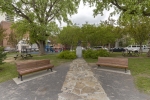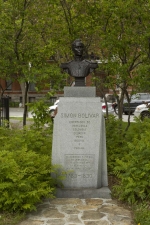Vital Dubray
Buste de Simon Bolivar
1991
Presentation of the artwork
Donated by the government of Venezuela to the Ville de Montréal, the monument was relocated in 1996 from Parc Percy-Walter to Parc Hector-Toe-Blake, in order to underline the contributions of the different Latin American communities established in Montréal. Composed of a base of grey granite and a bronze bust, it commemorates Simón Bolívar, South American general and statesman, as well as the independence of Venezuela, which took place in 1829. The waist-length bust, without arms, is the second one to sit on the monument, as the first bust was stolen in 1986. Cast in 1991 by the Fundición Artística La Fortaleza, it is a copy of the artwork by French sculptor Vital Dubray. The original work is conserved in Bueno Aires. Associated events
The monument commemorates Simón Bolívar and the independence of Venezuela, which occurred in 1829. Simón Bolívar was born in Caracas, Venezuela, in 1783. After studying in Europe, he was converted to the Napoleonic revolutionary ideal and vowed to liberate South America of its Spanish colonizers. He won his first victory in 1818 and gradually liberated Venezuela, Colombia, Ecuador, Peru, Bolivia, and Panama. He hoped to form a union bringing together South America, Central America and Mexico. He died in 1830 without having achieved this grand objective.
Vital Dubray
Gabriel-Vital Dubray (Paris 1813–92), known as Vital Dubray, studied sculpture with Jules Ramey. Under the Empire, he produced numerous works, including the sculpture of Jeanne Hachette for the town-hall square in Beauvais, France. His works are included in the collections of the Musée d’Orsay, the Musée du Louvre, and the Musée national des châteaux de Malmaison et de Bois-Préau. Vital Dubray was an Officer of the Legion of Honour.
Presentation of the artwork
Donated by the government of Venezuela to the Ville de Montréal, the monument was relocated in 1996 from Parc Percy-Walter to Parc Hector-Toe-Blake, in order to underline the contributions of the different Latin American communities established in Montréal. Composed of a base of grey granite and a bronze bust, it commemorates Simón Bolívar, South American general and statesman, as well as the independence of Venezuela, which took place in 1829. The waist-length bust, without arms, is the second one to sit on the monument, as the first bust was stolen in 1986. Cast in 1991 by the Fundición Artística La Fortaleza, it is a copy of the artwork by French sculptor Vital Dubray. The original work is conserved in Bueno Aires. Associated events
The monument commemorates Simón Bolívar and the independence of Venezuela, which occurred in 1829. Simón Bolívar was born in Caracas, Venezuela, in 1783. After studying in Europe, he was converted to the Napoleonic revolutionary ideal and vowed to liberate South America of its Spanish colonizers. He won his first victory in 1818 and gradually liberated Venezuela, Colombia, Ecuador, Peru, Bolivia, and Panama. He hoped to form a union bringing together South America, Central America and Mexico. He died in 1830 without having achieved this grand objective.
Vital Dubray
Gabriel-Vital Dubray (Paris 1813–92), known as Vital Dubray, studied sculpture with Jules Ramey. Under the Empire, he produced numerous works, including the sculpture of Jeanne Hachette for the town-hall square in Beauvais, France. His works are included in the collections of the Musée d’Orsay, the Musée du Louvre, and the Musée national des châteaux de Malmaison et de Bois-Préau. Vital Dubray was an Officer of the Legion of Honour.






